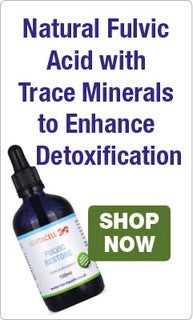It's sad but true that most seafood today is highly contaminated with toxic metals, industrial compounds, pesticides and herbicides.
Heavy metals like mercury, lead, copper, cadmium and arsenic naturally occur in our environment, but they significantly increase via industrial processes and agricultural chemicals. These, along with pesticides and other harmful contaminants leech into water sources.
Fish and marine life, in general, are exposed to concentrated levels, which accumulate in their organs and tissues, raising their risk of toxicity, particularly larger fish.
By now, many of us are aware of the health benefits associated with consuming oily fish at least twice a week. More of us are also becoming more informed about the potentially harmful contaminants in fish which is concerning – especially if you're pregnant or have young children.
A way to minimise your exposure to heavy metals such as mercury, for example, is to eat fish with lower levels such as anchovies, Atlantic mackerel and wild Alaskan salmon. Fish to avoid – those with higher levels – include tuna, sea bass, monkfish, halibut and swordfish. Greenpeace has a full list here.
To limit your exposure to PCBs, avoid fish like farmed salmon which have higher levels. Fish from contaminated areas with the highest levels tend to be bottom-feeding fish and larger predator fish. PCBs deposit in the fatty tissues and fatty fish are most at risk, so it's recommended to remove the skin and fatty areas and grill or bake fish to allow the fat to drain off.
Some people prefer to take fish oils as an alternative to regularly eating oily fish as it can provide some of the health benefits without the toxins. But not all fish oils are created equal. Toxic levels vary and according to researchers, 11%–62% of products are oxidised, risking exposure to unacceptable levels of oxidation which is potentially harmful to health.
This demonstrates how crucial it is to find a reputable fish oil brand which performs rigorous testing to ensure outstanding quality and safety.
What to look for in a fish oil

Quality and purity – This is paramount. You want to ensure your fish oil supplement is certified and provides ample nutritional value made from the finest, purest ingredients.
The quality should surpass standard requirements and ensure the product is free from harmful contaminants. Find a brand with label accuracy and projected efficacy to meet its claims.
Transparency – The product you choose should be open about where their fish oils come from, and what laboratory testing is performed to determine how safe and clean it is.
Sustainability – Any fish oil supplement worth taking should come from sustainably-sourced fish.
High potency – Get a fish oil with a high concentration of omega-3 EPA and DHA per capsule.
Wild sources – Steer clear of fish oils made from farmed fish (see below) and stick to ones made from wild fish.
So, what contaminants should you be aware of when it comes to ensuring your fish oil supplement is of the highest standard?
Fish oil contaminants to watch out for
Mercury
Although it occurs naturally in our environment, mercury levels rise significantly due to industrial activity. Once airborne, it invariably ends up in rivers, lakes and the sea.
It converts to methylmercury and deposits itself in marine food as well as passing over fishes’ gills in the water. It works its way up the aquatic food chain from microorganisms like algae to herbivores, then carnivores.
Larger and older fish tend to have higher levels as it has longer to bioaccumulate (become concentrated in their bodies). Large predatory fish like sharks and swordfish who feed on other fish that are loaded with mercury have higher levels still.
Mercury levels also depend on the area in which they swim. Methylmercury binds to protein which means that it accumulates in the muscles and tissue of fish.
According to Labdoor, when we ingest it, around 95% of methylmercury from fish is absorbed in the digestive tract. From there, it attempts to bind to molecules in protein-rich tissue, and roughly 10% manages to pass through the blood-brain barrier (which is not easy to do) and enter our brains.
Another 5% enters our bloodstream.
A 2003 U.S. study analysed 89 participants’ mercury levels over one year. They found that 89% of them had levels exceeding the maximum reference intake set by U.S. Environmental Protection. A high proportion of those with a diet rich in fish fell into this category.
If you eat high amounts of mercury-laden fish, over time, it can accumulate in your brain and contribute to some serious health problems.
It can affect your neurological system and lead to a decrease in fine motor skills, memory, concentration and dexterity, cause tingling around the mouth, ataxia, weakness, poor vision and hearing, and tremors.
It can also inhibit enzymes, disturb DNA synthesis and cause oxidative stress and inflammation – mainly in the brain.
PCBs
Polychlorinated biphenyls (PCBs) are highly toxic industrial compounds which are banned due to their serious health risks. They are fat-soluble and hard to degrade, and consequently, they are still very present in our environment.
There are 209 different PCBs which are mainly airborne but also found in water.
These persistent compounds collect in sediments at the bottoms of streams, rivers, lakes and coastal areas and accumulate in the fatty tissues and organs of fish and other animals.
Once again, if you consume a lot of fish, you could have high levels of PCBs, which over time can severely impact your health. Therefore, it’s essential to limit your consumption of certain fish that have higher levels.
Chlorinated PCBs found in water, eaten by fish and then by us, are hard for the liver to metabolise and rid from the body. So it accumulates, even at low levels of exposure.
PCBs can easily enter our cells and disrupt DNA and interfere with our endocrine systems, thyroid function and affect hormone balance.
They may also cause oxidative stress and reduce antioxidant capacity. Harmful to us at any age, repeated exposure to low levels of PCBs can put fetuses, babies and children at risk of neurological and developmental problems.
Bottom-dwelling fish are most likely to have higher PCB levels as it settles in the sediments in the sea, river and lake beds.
Levels of contamination will vary on the location of the fish and the species local to that region. Farmed salmon fed ground-up fish tend to be higher in PCBs than wild salmon.
Dioxins
The World Health Organisation classes dioxins as POPs (persistent environmental pollutants).
Dioxins can be naturally produced via volcanic eruptions and forest fires but are mainly a consequence of industrial processes like uncontrolled waste incinerators for solid and hospital waste, for example.
They belong to the ‘dirty dozen’, a group of highly toxic chemicals, found worldwide, accumulating in the fatty tissue of animals. The higher an animal is in the food chain, the greater its accumulation of dioxins.
Human exposure mainly comes from consuming fish, shellfish, meat and dairy.
Once ingested, dioxins get stored in our fat cells with an estimated half-life of seven to eleven years.
Toxic levels can impair liver function, immunity, fertility and endocrine function. Fetuses and newborns are particularly vulnerable as dioxins can affect developing organs and systems.
According to Cancer Research U.K., the International Agency for Research on Cancer classified one dioxin, TCDD, as carcinogenic to humans.
DDT
Pesticides, in general, continue to be of great concern for aquatic life. Scarily, DDT (dichloro-diphenyl-trichloroethane), an extremely toxic organochloride pesticide which is now banned for decades in most countries, is still damaging ecosystems.
Unexpectedly high levels of DDT and its degradation products were found in wild freshwater fish in 13 southern river sites in the U.K. between 2007 and 2012.
Levels in fish swimming in the river Lea were almost 20 times higher than the average from the other sites.
A Canadian study released in 2019 found that the levels of DDT and its toxic breakdown by-products were still incredibly high in the modern sediments of remote Canadian lakes in areas where intensive DDT spraying was carried out between 1952 and 1968.
Sadly, a valuable invertebrate, the small water flea Daphnia sp., has substantially declined, which appears to coincide with increased DDT.
This has had a significant impact on the food chain, potentially leading to higher algae production and less prey for fish. It would also be safe to assume that fish swimming in these waters are likely to have detectable DDT.
Animals and fish consume DDT from grass, algae and other plants growing in contaminated sediments and soil. Fish may also take it up through polluted sediment and water.
These days, the most common form of exposure to DDT in humans is via fish, dairy and meat. Although you can also get it from plant foods grown in contaminated areas and according to the CDC, leafy greens tend to have higher levels of DDT than other vegetables.
DDT is mostly stored in the fatty tissues of fish, animals and humans, and it leaves the body very slowly. It’s eliminated mainly via urine but can also be passed on to infants through breast milk.
High DDT can significantly affect the nervous system. Smaller exposure over a longer period may impact liver function and negatively affect blood quality.
DDT can alter lactation in breastfeeding women, and increase the risk of premature birth. There may also be a link between DDT exposure and the development of Alzheimer’s disease.
Beware of farmed fish

Depending on farming methods, farmed fish are often exposed to overcrowding, poor feeding practices, disease and pollution. Unfortunately, infection and contamination also have an impact on wild fish who share nearby waters.
Farmed fish are routinely fed antibiotics, pesticides and other compounds and are regularly given synthetic pigments to disguise the colour of their less appealing grey flesh.
Some countries like Norway are a little savvier and don’t allow fish farms near natural waterways where they can pollute, infect and endanger wild river, lake and sea-life, but this is not the case for many other countries.
Studies show dioxins, PCBs, mercury and other toxins are higher in farmed fish. This is in part as they are fed ground-up fish and other seafood such as krill (which has question marks over its population status and fishing practices and takes up a large percentage of feed). They are often also fed G.M. soy and other unnatural foods.
Conclusion
As you can see, you need to be vigilant about the quality of your fish oil supplements! It’s often worth paying more to get the purity, potency and transparency that is necessary to guarantee safety and peace of mind.
We firmly stand behind our range of WHC fish oils which guarantee quality, purity, transparency, sustainability, and high potency from smaller breed wild fish sources like sardines and anchovy.
The WHC fish oil range covers cardiovascular health, brain function and vision, and supplements for children. Why not give them a try?
Written by Rebecca Rychlik, Nutritional Therapist and Homeopath. Follow Rebecca on Instagram, Facebook and Medium, @rebeccabitesback.
Water for Health Ltd began trading in 2007 with the goal of positively affecting the lives of many. We still retain that mission because we believe that proper hydration and nutrition can make a massive difference to people’s health and quality of life. Click here to find out more.




























Leave a comment